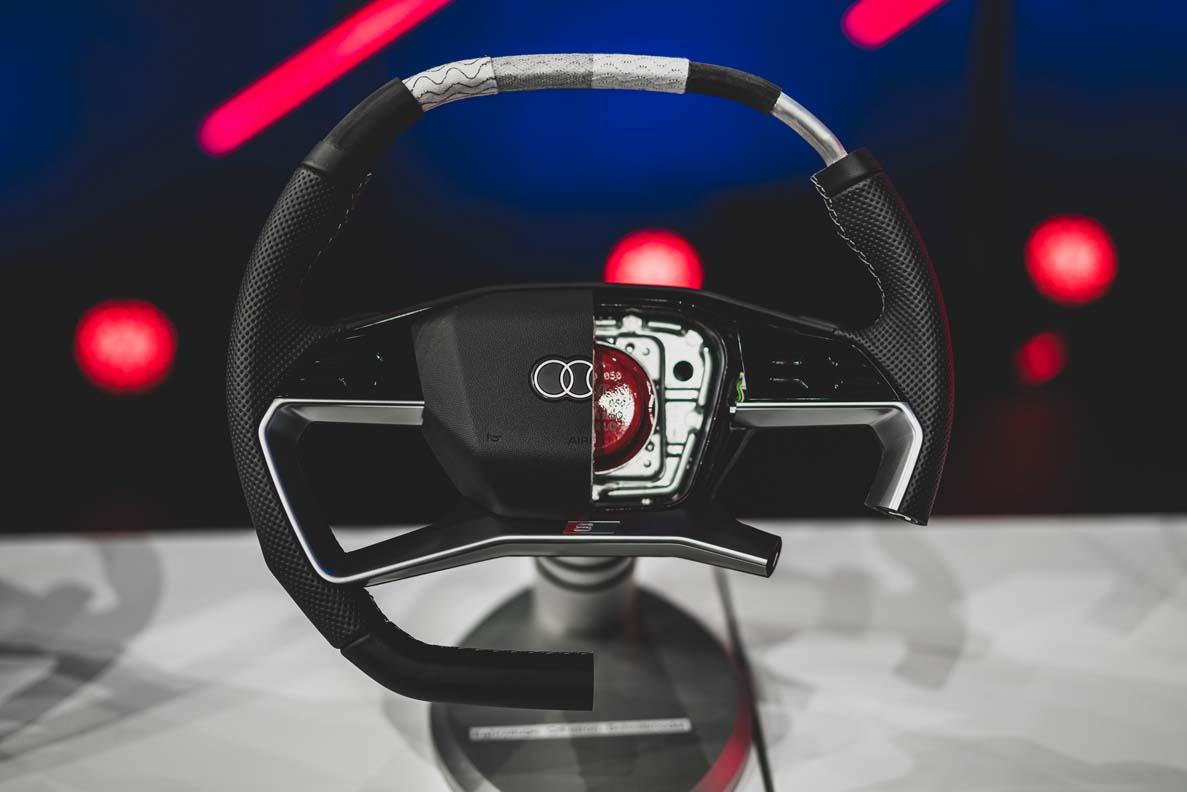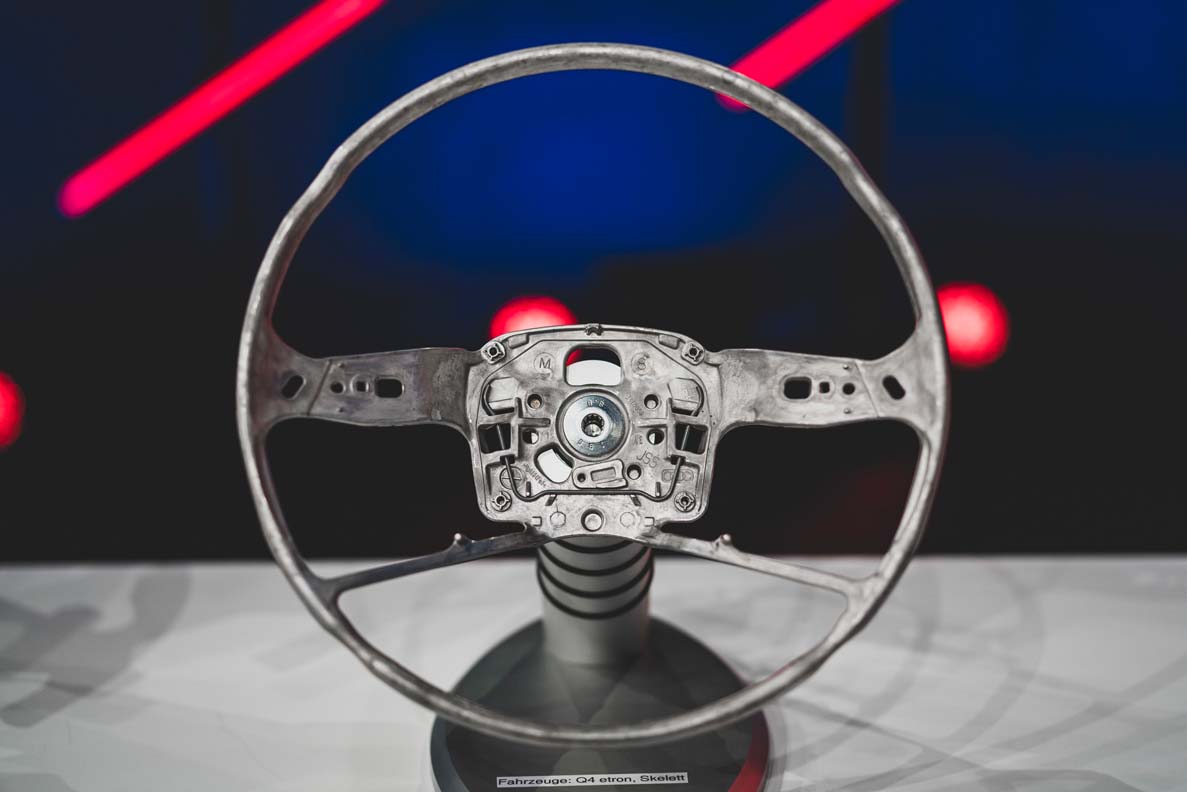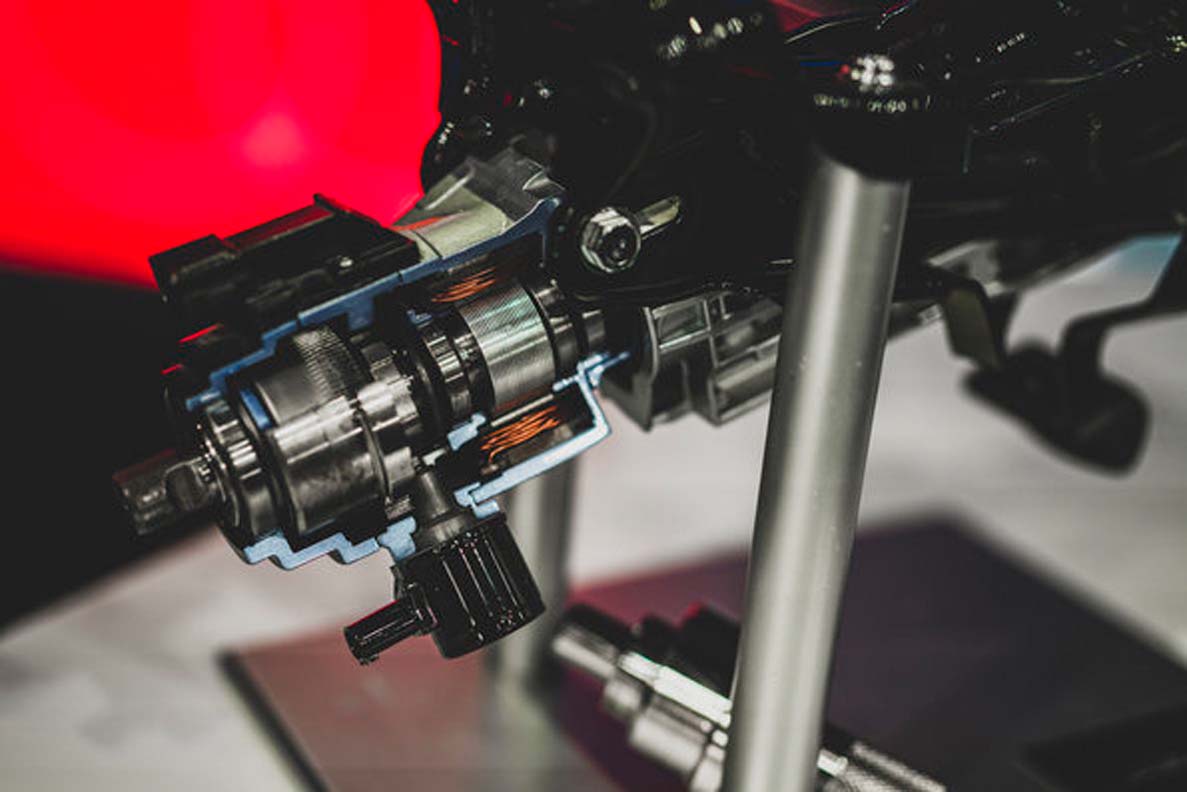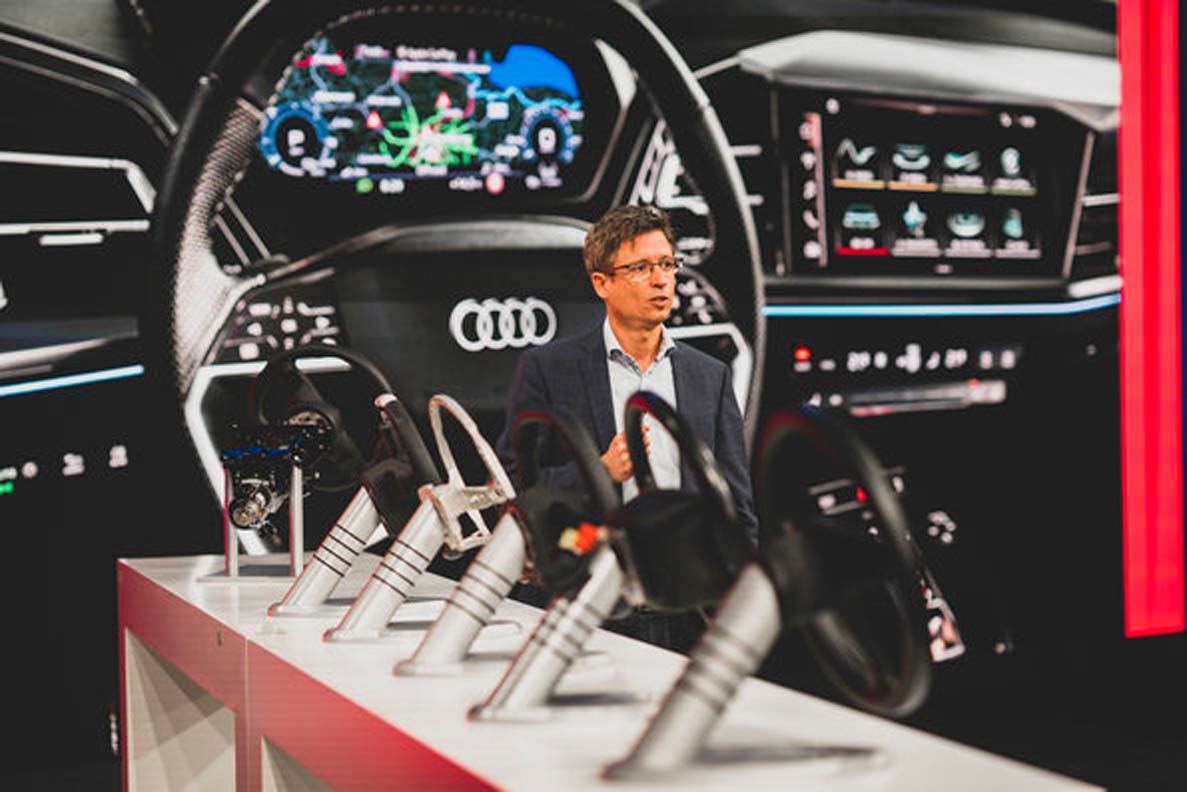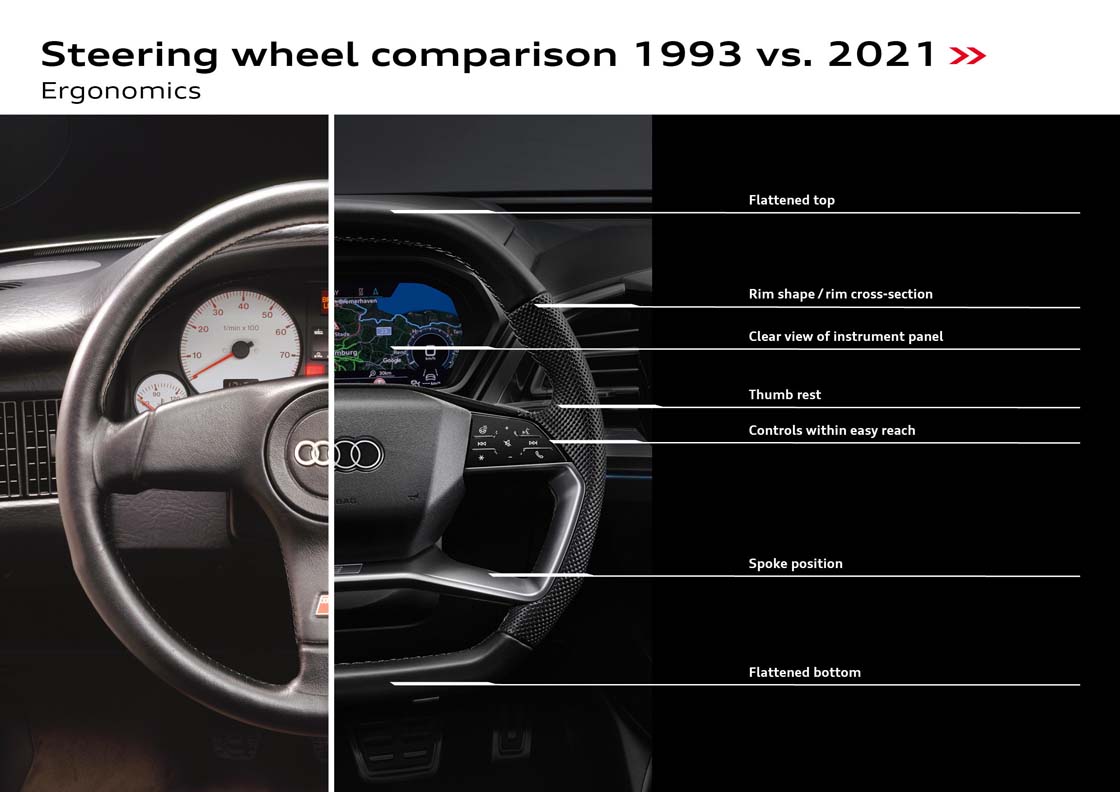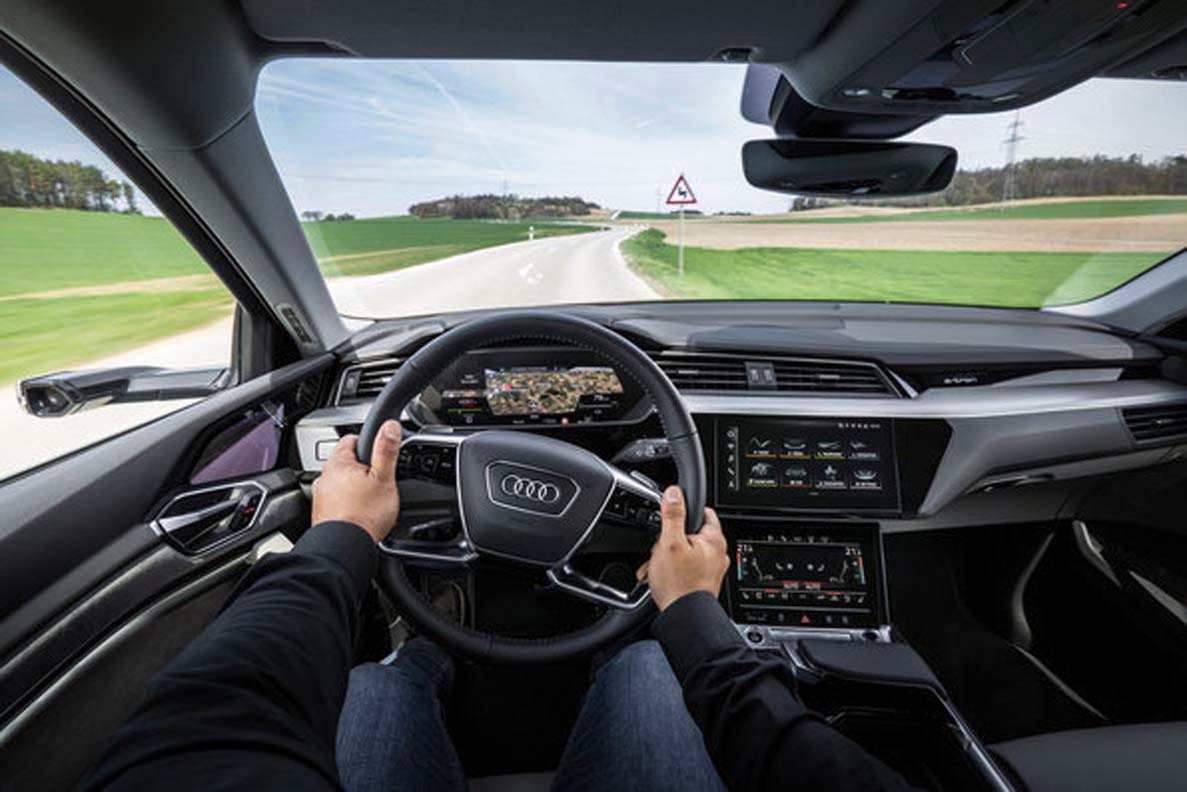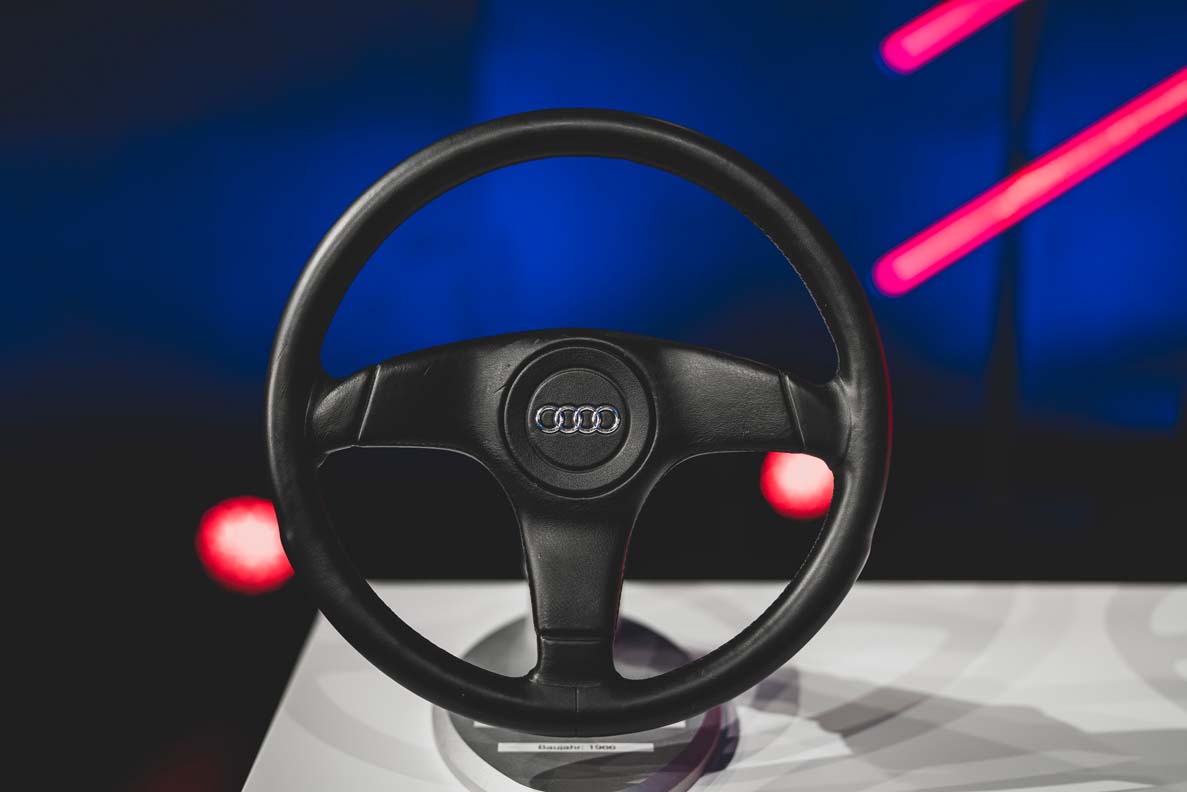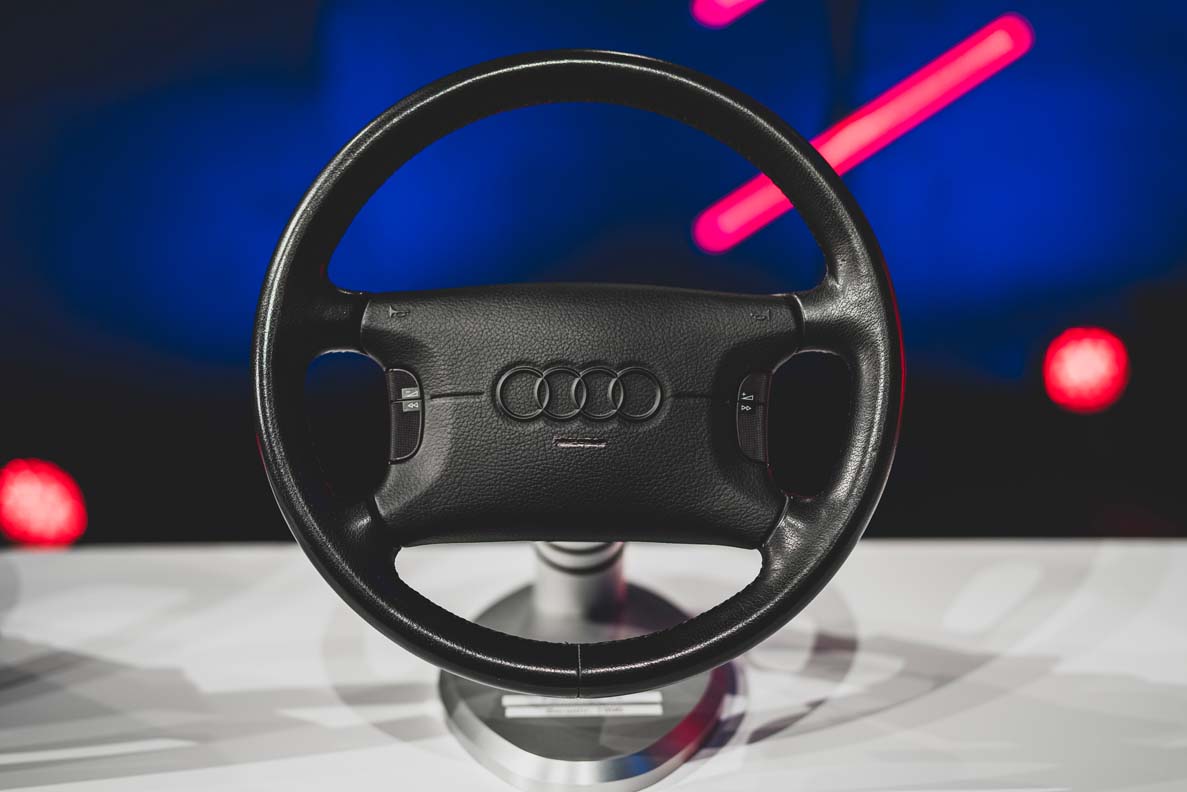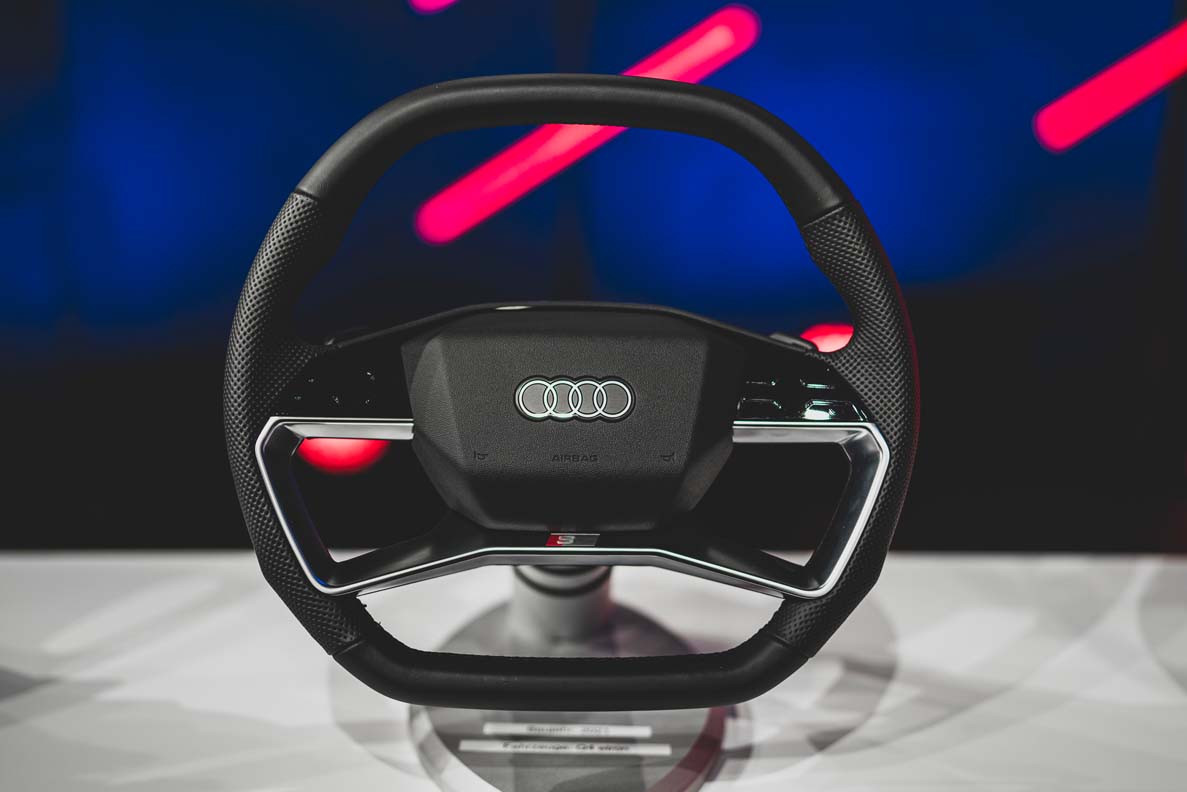
The steering wheel is almost as old as the automobile itself. And it is a given that a vehicle will drive in the direction desired according to the motion of the steering wheel. But the technologies behind it are complex and have become increasingly sophisticated in recent decades. The developers at Audi are working on the perfect combination of dynamic handling and comfort. At the same time, steering assistance functions offer added safety and support in everyday driving – for changing lanes, swerving, and parking. As a result, the steering wheel is increasingly emerging as a communication device, moving away from the standard wheel and toward becoming a high tech command center.
What constitutes the steering feel typically found in an Audi?
Hand moment and feedback are crucial for steering feel. Every Audi can be smoothly and precisely steered with minimal effort while maneuvering and parking – the car drives effortlessly. That is another way of saying it has low hand moment. This increases at higher speeds. The result is agile handling and optimized driving dynamics – the vehicle can be moved through curves with precision. Its sporty character is undergirded by a controlled, stable feeling in the steering wheel’s middle position. This is noticeable during steady, straight driving at expressway speeds, which is affected not only by speed, but also by side winds that arise and road conditions. The driver still has to countersteer, but with significantly less hand moment. A sensor continuously measures the wheel’s steering angle. The steering wheel’s self-aligning force is always noticeable precisely from its middle position and increases perceptibly up to high lateral force. Optimal steering feel also means that a car responds to steering commands with an imperceptible time delay. The latency between steering wheel and implementation on the axles only amounts to a few milliseconds.
What factors affect steering feel?
The steering balance is fundamentally affected by the big three of driving physics: longitudinal, lateral, and vertical dynamics. So apart from the vehicle’s acceleration and deceleration, the lateral forces that arise when driving through a curve as well as wheel-load fluctuations and sprung mass vibrations in the chassis also have an effect. The main objective for Audi’s engineers is appropriate feedback from the front-axle forces with respect to driving conditions, balance, grip level, and bumps in the road. Well-calibrated steering responds predictably and in a linear or progressive way depending on the situation. And it always communicates when the limits of physics have been reached. For example, steering torque decreases noticeably when the car reaches the highest possible cornering force on the front axle, which is to say when understeering starts. For that reason, steering makes an essential contribution to a feeling of safe driving.
How does each model gain its individual steering character?
At Audi, hand moment is established within a defined area. Each model attains its specific steering character within that range. For example, as compact cars, S and RS models offer higher hand moment than the Audi A1 or A3. On top of that, the fine tuning of the steering system within a series differs between engine or chassis variants. The developers’ goal is always optimally balanced steering characteristics that feature a typical balance between driving safety, comfort, and sportiness for each individual series. Customers can use Audi drive select to adjust the steering characteristics in various modes. In the “dynamic” driving profile, for instance, they get higher hand moment than in the “comfort” setting.
From steel frames to high-tech steering – the evolution of the Audi steering wheel
The steering wheel is much more than a tool for changing direction: it is the digital control room and the most important interface between human and machine. Today’s Audi drivers operate up to 18 functions via multifunction buttons – from communication to infotainment to comfort features. Audi steering wheels have therefore turned into real command centers. In that respect, they all have one thing in common: they share Audi’s standard sporty look, lie ergonomically in the driver’s hands, and offer high functionality with intuitive operation.
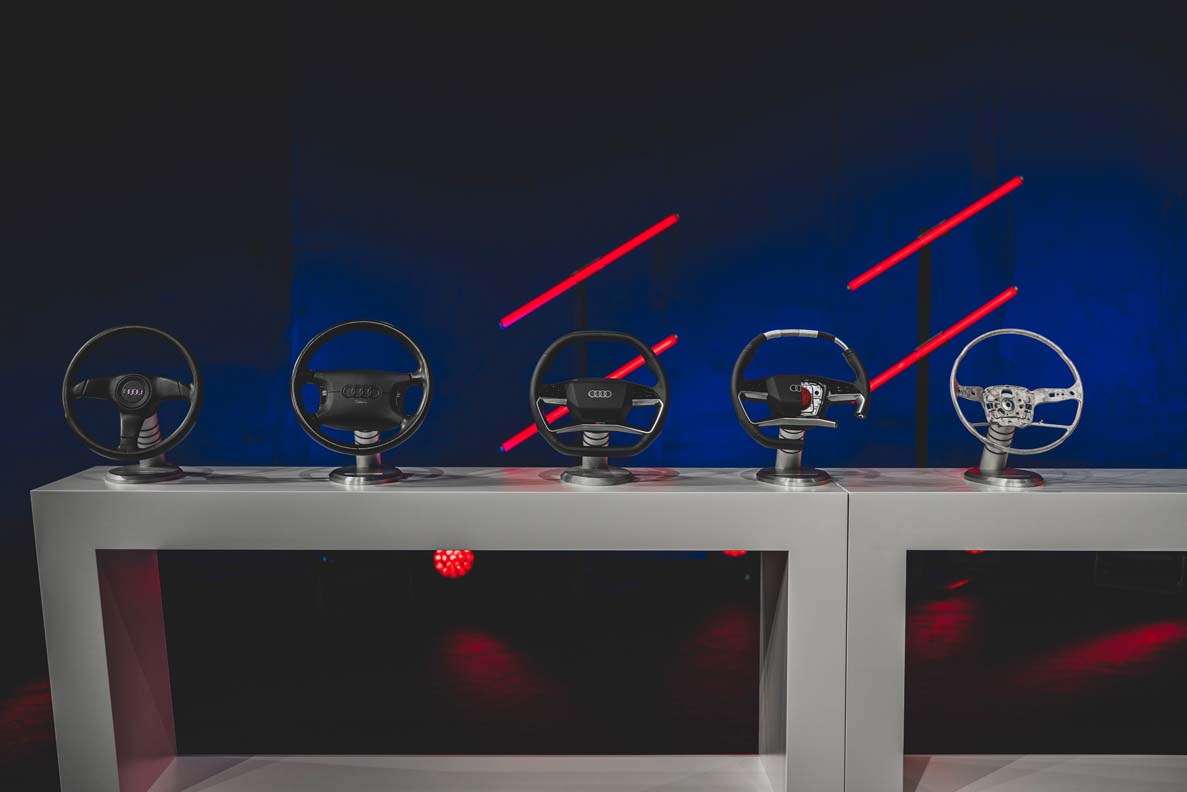
Why do we all actually use steering wheels?
The steering wheel has been the dominant feature inside the car for over 120 years. In the beginning, there was a steering lever or handle bar. That is how the occupant would change the wheels’ steering angle. However, steering was anything but precise or flexible. With the steering wheel design, French engineer Alfred Vacheron developed a technical alternative for the first time in order to optimize the controls over the steering precision of the front wheels with his “volant.” The clou: the circular controller enabled the steering angle to be transmitted in multiple rotations. Shortly after it was introduced, the steering wheel evolved into the worldwide standard.
How has the Audi steering wheel changed over time?
Even Audi’s earliest series vehicles like the Type A and Type B were equipped with wheels like that, which at the time were still oversized steering wheel rims. A lot has happened since then – the steering wheel has developed evolutionarily with the car. Thanks to hydraulic power steering, which Audi introduced in the 1980s, it became smaller and more manageable. Its structure and function have also changed. By the end of the 1980s, a steering wheel with a composite frame that only integrated the horn function was still being used. In 1991, the driver-side airbag became standard. the first buttons were also introduced, such as volume control and the skip function.
Today, Audi’s latest generation of steering wheels consists of a diecast frame that is significantly lighter than steel constructions and has other advantages with respect to strength, dampening characteristics, and castability. It offers up to 18 functions and capacitive grip recognition, which supports assisted steering interventions and has found its way into all Audi steering wheels.
What determines the design and ergonomics of a steering wheel?
Fixed sizes have become established for design and feel. The rim geometry determines the overall shape of each steering wheel. There is a credo at Audi: The rim’s geometry and center should be as small and compact as possible. At the same time, steering wheels should have a sporty design. Audi established 375 millimeters (14.76 inches) as the scale for steering wheel diameters and that applies in all series. The oval design of the rim profile corresponds to a naturally closed palm contour. The diameter of the rim is about 30 to 36 millimeters (1.18 to 1.42 inches), which already represents the lower limit of what is possible given the capacitive grip recognition and steering wheel heating. All these steering wheels are double foam cushioned and therefore offer very good surface homogeneity and a nonslip feel. The position of the radius arm has to fit the basic layout of the sitting position and should not obscure the driver’s view of the shift paddles or the pitman arm. Compared with the competition, the radius arms in Audi steering wheels really have a very slender design – a challenge in terms of strength and crash safety. Another tenet: all controls have to be reachable with either thumb without affecting the task of driving.
Bias, height, depth: what influence does the position of the steering wheel have on ergonomics?
The bias of the steering wheel always depends on the driver’s sitting position and is between 17 and 24 degrees, depending on the vehicle concept. In Audi SUVs, the angle is between 22 and 24 degrees; in compact cars, limousines, and Avant series, it is 17 to 21 degrees. In sporty models, where the driver sits relatively low and upright, the steering column’s bias is very flat. That means that the steering wheel is angled very steeply in the driver’s direction. Regardless of the vehicle concept, a view of all displays always has to be assured. In all Audi models, the height and depth of the steering wheel can be adjusted in the area of +/- 30 millimeters (1.18 inches) so that every driver can find their own individually appropriate sitting position. In general, there should be about 25 to 30 centimeters’ (9.84 to 11.81 inches) distance between the driver’s upper body and the steering wheel and the driver’s arms should be bent slightly.
How do airbags and functional versatility limit steering wheel design?
Designers and engineers work very closely together on steering wheel design at Audi. The critical parameters are the rim diameter, the constructed space for the driver-side airbag, and the number of switches, which together determine the width of the radius arms. When the airbag was introduced, the center of the steering wheel had to become significantly larger because the first generation collision cushions that were hidden in there were extremely bulky. As they developed further, the airbags could be folded more and more. At the same time, their function depends significantly on their materiality: of course the contours of the tear lines have to be invisible, but when a crash happens, these predetermined breaking points have to open in an instant. In terms of the number of switches, Audi stipulates that only functions that the driver needs quick access to while driving are integrated into the steering wheel. That includes, for instance, controlling entertainment and the virtual cockpit as well as voice-operated controls and telephony. The controllers for the assistance systems, windshield wipers, and blinker functions are always in the same place on the pitman arm.
What makes the new generation of steering wheels in the Q4 e-tron so special?
The steering wheel in the Audi Q4 e-tron and Q4 Sportback e-tron sets new standards in design, ergonomics, and functionality. It integrates 18 functions in all, which can be operated for the first time via touch screens with a black panel look. Their function areas are back-lit and indicate which buttons are active that way. When they are inactive, the high-gloss black touch screens are virtually invisible. The four rings on the impact absorber still have a flat design, which is to say they are two-dimensional. Another novelty is the steering wheel rim, which is flattened on the top and bottom for the first time. That gives the interior a more futuristic effect, emphasizes its progressivity, and facilitates getting in and out of the vehicle. The latter is also affected by what is known as axial offset. That means that the steering wheel is minimally displaced – by 7.5 millimeters (0.3 inches) – above the steering-wheel hub. That optimizes the driver’s view of the controls, space for getting in and out of the vehicle, and the rotation characteristics of the steering wheel.
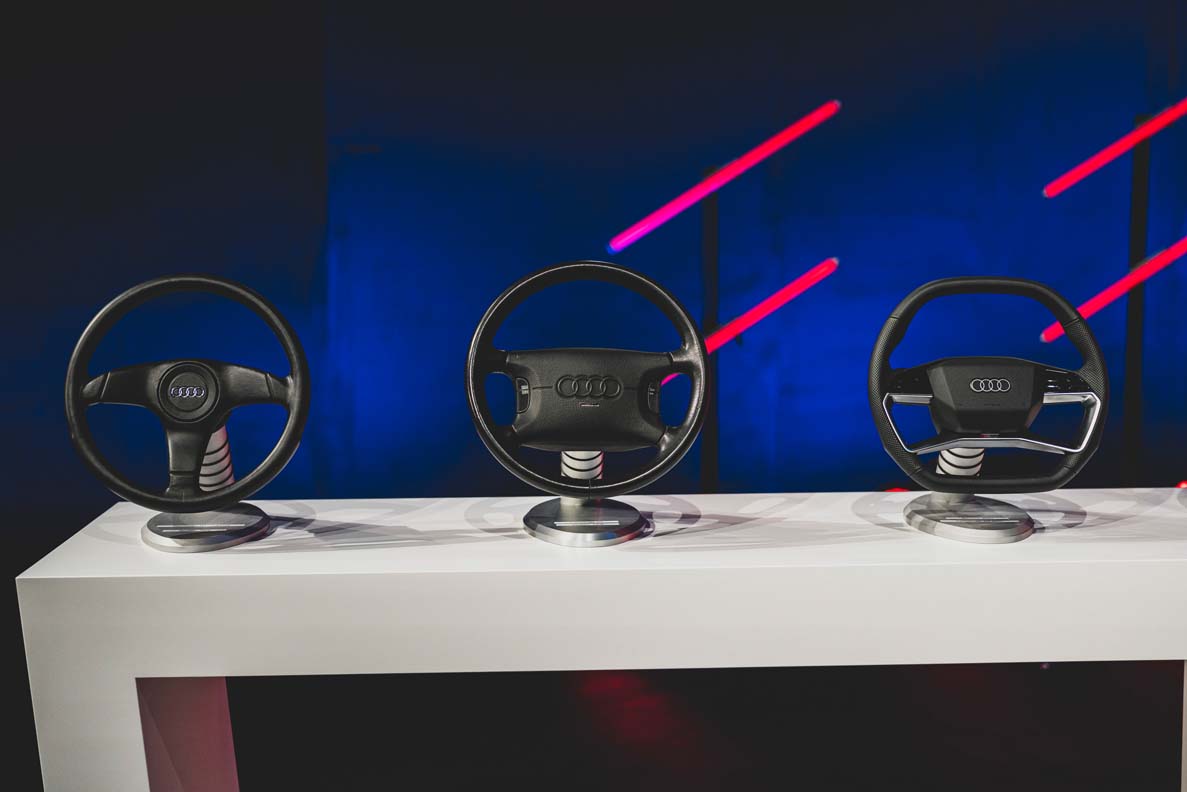
Can the touch screens really be operated intuitively?
Small bumps form an outline between the touch screens and make them easier to use. When a person touches the screen with a finger, it does not instantly trigger a response. The system registers an action and gives haptic feedback only when the driver gently presses with a certain force. This involves the same technology as in the MMI touch in the center console. A panel that is activated via a pressure point recognizes the finger position. Then there is a mechanical clicking sound upon activation. That way, the driver can get oriented intuitively using his or her sense of touch. With its operation concept, Audi is integrating a technology into the steering wheel that we already know from smartphones and tablets. So apart from touch, there are also swipe movements, for instance for scrolling through navigation, media, and vehicle function menu lists.
Intelligent steering
Intelligent controllers and assistance systems not only increase comfort and infotainment offerings in the car, but also optimize an Audi’s driving dynamics and steering feel.
What is hands-on detection?
Capacitive grip recognition is referred to as hands-on detection. It supports assisted driving functions with steering intervention and thereby creates added safety – when changing lanes, swerving, and parking. A sensor pad underneath the outer layer of foam in the steering wheel rim can tell whether or not the driver has his or her hands on the wheel. It does not require force or pressure; it can sense even a very gentle grip to enable relaxed driving operation. The control unit integrated into the steering wheel continuously assesses that contact and recognizes if the driver is ready to engage with traffic. The steering wheel cannot go longer than 15 seconds without being touched. After that, a series of visual and acoustic warnings will occur. As a result, the new generation of steering wheels is increasing comfort in comparison with steering torque-based solutions. That is because drivers previously had to actively move the steering wheel to signal to the assistance systems that they were in control of the car, even on straightaways.
Under what circumstances is steering assisted?
Some assistance systems help the driver in critical situations with corrective steering interventions. Adaptive cruise assist (ACA) with its integrated active lane assist keeps the car consistently in the middle of the lane. If it gets close to lane markings without a turn signal on, the system helps the driver to steer back into the lane by means of gentle but noticeable steering interventions. Upon driving across lane markings, the driver can be warned via haptic feedback.
Traffic jam assist – which is also a subsystem of ACC – assists over a speed range up to 65 km/h (40.4 mph) in vehicles with an automatic transmission, as long as traffic is moving slowly. The assistant guides the car by making gentle steering movements and orients itself to lane markings, roadside structures, and other vehicles.
Collision avoidance assist can help the driver in a swerving situation that it recognizes as critical in order to steer the vehicle around an obstacle. If the driver actively avoids the obstacle after receiving the urgent warning, collision avoidance assist helps by applying targeted braking to the wheels and increasing or reducing steering torque. So if the driver steers too far, the system reduces the steering torque and if the driver does not steer far enough, it increases steering torque. The assistant helps in the same way when changing back into the lane.
Park assist assumes completely automatic steering. After it has identified an appropriate perpendicular or parallel parking space by means of ultrasonic sensors, it automatically steers the vehicle in. The driver only has to accelerate, shift gears, brake, and supervise the parking procedure.
How does the Electronic Chassis Platform affect steering?
A modern car has about 100 control units, each of which is responsible for just one function. However, the trend is toward intelligent and central control units that can simultaneously combine multiple functions with tremendous processing power and a fusion of radar, camera, ultrasonic, and lidar sensors. When calibrating chassis components and the steering system, Audi relies on the Electronic Chassis Platform, or ECP for short. The multi-control unit was used for the first time in 2015 in the Q7 and today, from the A4 and up, it is built into all of Audi’s mid-sized, full-sized, and luxury models. It processes all onboard information and sensor signals with respect to speed, the vertical, roll, and pitch movements of the car, and situational driving behavior like oversteering and understeering. The ECP uses that information to continuously generate a snapshot of the driving situation and the coefficient of friction between the tires and the road. With data from numerous suspension systems, the Electronic Chassis Platform calculates the optimal function for the individual components in milliseconds.
Audi steering systems
At the moment, five different Audi steering systems contribute to agility, comfort, and safety in road traffic. Across different models, they represent effortless, controlled driving with Audi’s standard steering character, which ensures precise and sporty implementation of steering movement. The top system is the Dynamic All-wheel Steering. With that system, Audi is exploring the limits of what is physically possible and combining manageability with extremely high precision.
State of the art: electro-mechanical power steering
Electro-mechanical power steering is today’s state of the art and can be found in every modern premium car. The system functions without hydraulic components and thereby saves a significant amount of energy. It also makes all assistance systems with steering intervention technically possible. Electro-magnetic power steering offers speed-adjusted steering assistance and contributes to directional stability. That way, the driver has a sporty steering feel and gets extremely precise, finely differentiated feedback from the roadway.
A wide field of application: electro-mechanical progressive steering
“Progressive” means that steering is implemented differently depending on the angle of the steering wheel. The steering rack and pinions are specially shaped and geared for that purpose. At a sharp steering angle, the gear ratio is smaller and the steering very direct. When the driver has to maneuver or park, all it takes is two and a half rotations of the steering wheel between both maximum positions. Drivers will experience a more dynamic ride on winding highways due to the more direct gearing. The power steering boost adjusts to the driving speed. At low speeds, it is at a high level for easier maneuverability and it declines as the speed increases. Electro-mechanical progressive steering is the most widespread steering technology at Audi.
Reduced rotation: dynamic steering
Dynamic steering varies its degree of implementation up to 100 percent, depending on driving speed, steering angle, and the mode selected in the Audi drive select dynamic handling system. The central component is the superimposition gearing in the steering column. It conveys the driver’s steering commands just as directly as in a vehicle with a conventional steering column. There is also a direct mechanical link to the actual steering gear on the front axle and the associated feedback to the forces on the wheels. When the superimposition gearing is controlled by the electric motor, it increases or decreases the steering angle, which constantly adjusts the steering ratio according to the given driving situation. That improves steering comfort and tracking behavior in accordance with speed and driving situation. At low driving speeds – in city traffic and while maneuvering – dynamic steering operates very directly; all it takes is two full turns to go from end stop to end stop. The power steering boost is also high, which makes parking and maneuvering easier. On country roads, the directness of the steering response and electric assistance are progressively reduced. Indirect gear ratios and low power assist are used to smooth out unsteady steering movements and enable straight tracking at fast expressway speeds.
Four the win: all-wheel steering
With the Q7, Audi introduced all-wheel steering in 2014 and, in doing so, set a new standard with respect to agility. The system can adjust the steering angles on the front and rear axles independently of one another. It uses the electro-mechanical power steering in the front and rear axle steering with an electric spindle drive and two tie rods in the back. The signal to turn is electrically transmitted to the steering linkage and actuators in the rear of the car via a drive-by-wire system. At low speeds, the back wheels turn up to five degrees in the opposite direction of the front wheels. That reduces the turning radius by about one meter (3.28 feet) and is particularly beneficial when maneuvering and parking.
Starting at speeds of about 60 km/h (37.28 mph), however, the rear wheels follow the movement of the front wheels. Turning up to two degrees in the same direction makes driving behavior at highway and expressway speeds calmer overall and increases stability in swerving situations. Additionally, the all-wheel steering helps make Audi’s luxury-class SUVs among the most agile models in their segment.
Top combination: Dynamic All-wheel Steering
An advance in all-wheel steering, the Dynamic All-wheel Steering that is optional in the Audi A6, A7, and A8, is standard equipment in the S81. It is currently the top technology among Audi’s steering systems and combines dynamic steering on the front axle with rear-axle steering. With that system, Audi is exploring the limits of what is physically possible. The system offers significant benefits, specifically in the threshold range. It combines direct, sporty steering response with masterful driving stability or, in brief: manageability with extremely high precision. The overall steering ratio changes within a range from 9.5 to 17.0 – direct at low speeds and stable at high speeds.
